Leicester Tramways Company
History
Leicester's standard-gauge horse tramway, which was owned and operated by the Leicester Tramways Company Limited, opened on the 24th December 1874.
The men behind the LTCo were Daniel Busby and William Turton, two well-known tramway entrepreneurs, who had interests in several horse tramways in the north of England, most notably, those of Manchester, Leeds, Liverpool and Salford. Powers to construct the tramway were obtained in 1873, though the support of Leicester Corporation came at the price of an annual payment, a share in the profits above a certain threshold, and a right to buy the tramway after 12 years. Busby and Turton were however canny operators, reconstructing the company in 1877 and managing to pay a handsome dividend every year (bar the four years from 1887 to 1890, when extensive track renewal took place) but never high enough to trigger additional payments to the corporation.
The initial line was supplemented by additional lines and extensions in 1875, 1878 and 1884, taking the system to its final size of 12.06 miles. Lines radiated from the Clock Tower: northwards to the Folly Inn in Belgrade; northeastwards along Humberstone Rd to a terminus at its junction with Uppingham Rd; southeastwards along London Rd to a terminus at its junction with Knighton Drive; southwestwards along Welford Rd and Aylestone Rd to the latter's junction with Grace Rd; and northwestwards along Church Gate, Sanvey Gate and Woodgate to a terminus at Groby Rd.
The company experimented with steam traction during 1876, using a Hughes steam tram built at the nearby Falcon works at Loughborough; although reasonably successful, the company decided against introducing steam traction, and continued to employ horse traction right through to its takeover in 1901.
In the mid-1880s (it is unclear exactly when), rather than build a tramway extension from the London Rd terminus out to Oadby, for which it had obtained powers in 1884, the LTCo rather precipitately chose to introduce a horse omnibus service, one which directly competed with the omnibus service of Solomon Andrews, who had been operating in the town long before the tramway. Unfortunately for the company, Solomon Andrews was no local minnow who could simply be pushed aside, but a well-known Cardiff-based omnibus proprietor and entrepreneur. At this time, he was involved in several tramway/omnibus wars across the country, particularly with the Provincial Tramways Company, so knew what he was doing when it came to putting up a fight. He responded by introducing new omnibus services that directly competed with those of the tramway company, a move which quickly led to a significant downturn in the LTCo's takings (and presumably, profits). The situation was finally resolved in November 1887 when the LTCo reached agreement with Andrews, purchasing his Leicester assets and in so doing, considerably expanding their omnibus operations.
Although the corporation had the right to purchase the tramway after 21 years had elapsed, i.e., in 1895, it chose not to do so. However, notice of the corporation's ultimate intent was clear for all to see in 1897, when it obtained powers — within the Leicester Corporation Act of that year — to construct a municipal tramway, and to compulsorily purchase the LTCo. The corporation exercised its right four years later, taking over the LTCo (including its horse omnibus operations) on the 1st July 1901.
The corporation then, however, spent an inordinate length of time deciding which lines to build and more perniciously, hand-wringing over the precise form of traction they wished to use. Work on the new tramway and conversion of the existing horse lines to overhead current collection did not therefore start until early 1903, the first corporation electric tram service running on the 18th May 1904. The last horsecar service ran just over five months later on the 31st October 1904, the corporation having operated the horse trams for over three years.
Uniforms
The Leicester Tramways Company operated horse-drawn trams for just over a quarter of a century, from 1874 through to the municipal take-over of 1901. In common with the majority of horse tramway operators in the UK, company drivers wore informal but smart attire — trousers, jackets, waistcoats, shirts and ties. Headgear appears to have largely followed the fashion of the day, predominantly the bowler hat, though later on, flat caps and straw boaters also made an appearance; neither the jackets nor the hats bore insignia.
Conductors on the other hand appear to have worn short jackets and kepi-style caps; the coats do not appear to have carried any insignia, and were probably not formal issues (different styles are seen in surviving photographs, implying that they were purchased by the employee rather than issued by the company). In the early days, the caps were tall and rigid, rather like Victorian postmen's kepis, but later on they were soft-topped and noticeably smaller in profile. It is currently impossible to say whether the caps carried any badges, though surviving photos would suggest not.
Both drivers and conductors wore round licences, which were suspended from their jackets by a leather strap; the licences were made of brass and carried the full company title and a grade around the outside ('DRIVER' and 'CONDUCTOR'), and with a number in the centre.
Photographs of inspectors are unknown.
Further reading
For a largely pictorial history of Leicester's tramways, see: 'Leicester's Trams' by Geoff Creese; Irwell Press (2000).
Images
Drivers and conductors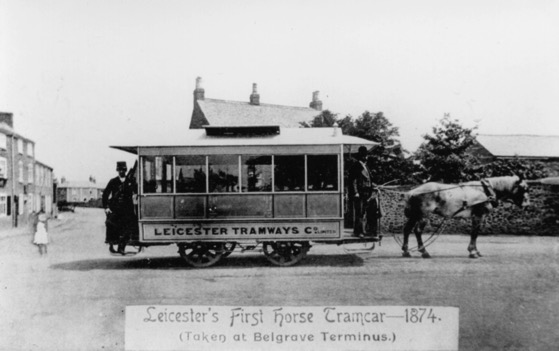
A very early shot, circa 1875, of a Leicester horse tram at the Belgrave terminus. Photo courtesy of the Tramways and Light Railway Society, with thanks to David Voice.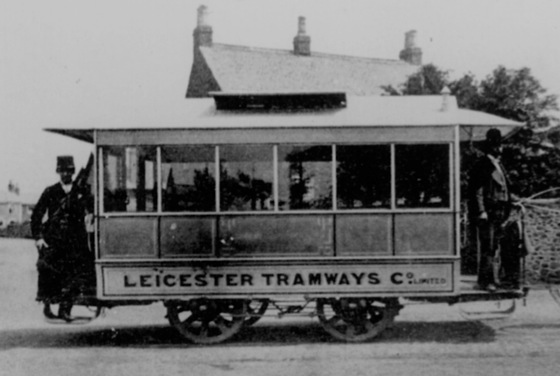
A blow-up of the above photo showing the crew in a little more detail. The conductor is wearing a tall cap, probably issued by the company, whilst the driver has the standard horseman's tall bowler hat.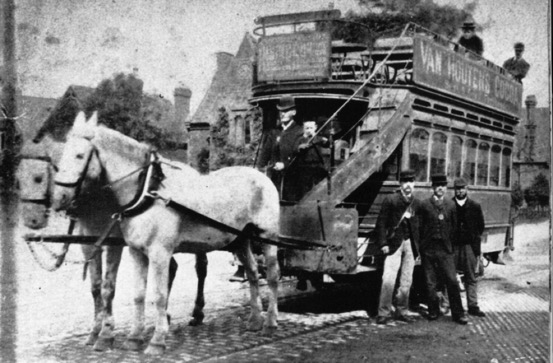
An unidentified horse car with driver (left) and two conductors — photo undated, but probably taken in the late 1880s or early 1890s. Photo courtesy of the Tramways and Light Railway Society, with thanks to David Voice.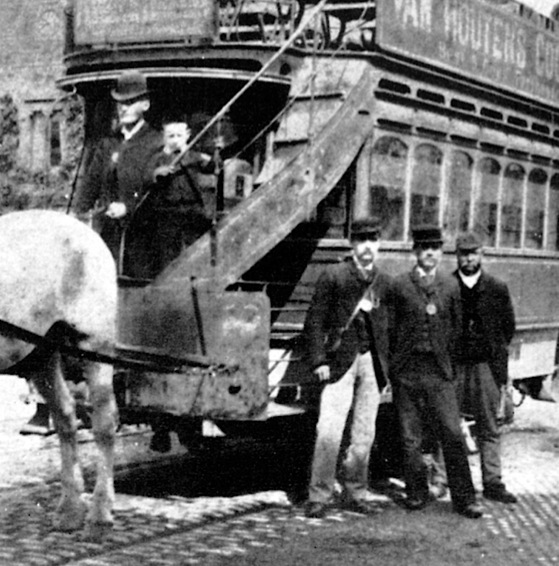
An enlargement of the above photograph showing the driver (with a small boy alongside him on the stairs, no doubt his son) and the two conductors; the other individual may well be a driver, meaning that two crews are depicted. Whilst the driver on the platform is wearing the tall bowler of the period, both the conductors are wearing soft-topped peaked caps; all three are also wearing licence badges.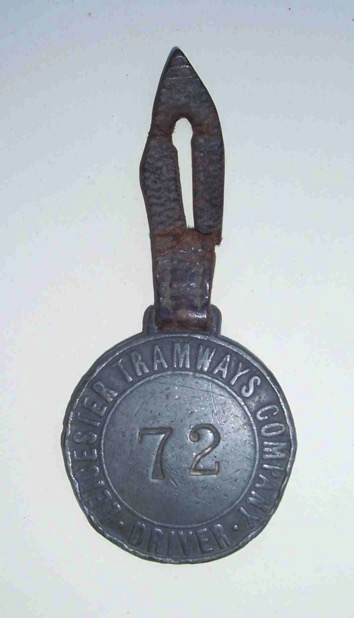
Horse tramway driver's licence — brass. John Burford Collection.